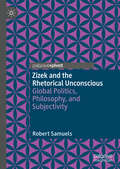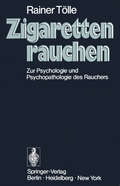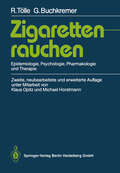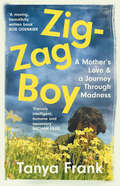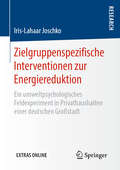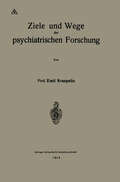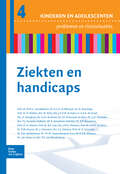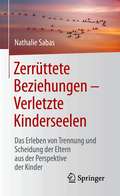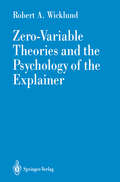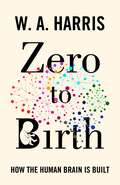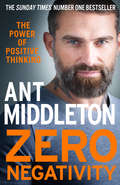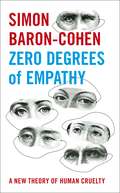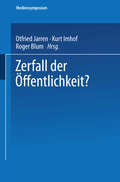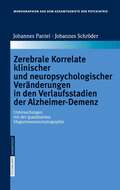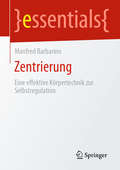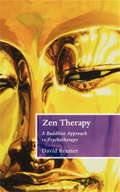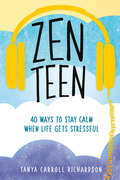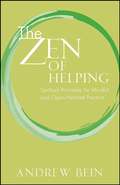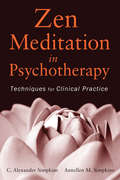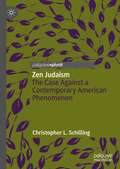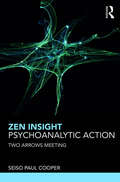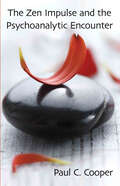- Table View
- List View
Zizek and the Rhetorical Unconscious: Global Politics, Philosophy, and Subjectivity
by Robert SamuelsThis book builds on a critique of Slavoj Zizek’s work to outline a new theory of psychoanalytic rhetoric. It turns to Zizek because not only is he one of the most popular intellectuals in the world, but, this book argues, his discourse is shaped by a set of unconscious rhetorical processes that also determine much of contemporary politics, culture, and subjectivity. Just as Aristotle argued that the three main forms of persuasion are logos (reason), pathos (emotion), and ethos (authority), Samuels describes each one of these aspects of communication as related to a fundamental psychoanalytic concept. He also turns to Aristotle’s work on theater to introduce a fourth form of rhetoric, catharsis, which is the purging of feelings of fear and pity. Adding a strong voice to current psychoanalytic debate, this book will be of value to all scholars and students interested in both the history and modern developments of psychoanalytic theory.
Zigarettenrauchen: Epidemiologie, Psychologie, Pharmakologie und Therapie
by Rainer Tölle Gerhard BuchkremerEinerseits ist Rauchen ein Vergnügen, das Befriedigung verschaffen und angenehme Wirkungen hervorrufen kann. Die Zigarette ist Genußmittel und Psychopharmakon zugleich, sie erleichtert Kontakte und fördert Gemeinsamkeit. Andererseits ist Tabak ein Gift, das schwere Gesundheitsschäden verursacht. Diese Gefahr wird durch die Ni kotinabhängigkeit vergrößert; denn süchtiges Rauchen ist nicht leicht zu durchbrechen, so daß die Vergiftung fortgesetzt wird. Eugen Roth sagt das in einem Vierzeiler: "Bei Nikotin und Alkohol/fühlt sich der Mensch besonders wohl / Und doch, es macht ihn nichts so hin / wie Alkohol und Nikotin." Daher kann es nicht verwundern, daß Rau chen kontrovers beurteilt wird. Die Einstellung zum Tabak war von jeher zwiespältig. Nachdem mit der Neuen Welt der Tabak entdeckt (Columbus 1492) und nach Europa exportiert wurde (1519), ent stand große Begeisterung. Tabak war heiß begehrt. Bald aber kam auch Kritik auf. Befürworter und Gegner ergingen sich in starken Worten. Die Kontroverse wurde auf medizinischer, ästhetischer, ethischer, politischer und wirtschaftlicher Ebene geführt. Tabak wurde als Heilmittel hochgelobt, z.B. von R. Burton in einer Schrift über Melan cholie (1621): "Tabak, göttlicher, einzigartiger, alles übertreffender Tabak, der alle Wundermittel weit übertrifft, trinkbares Gold und Stein der Weisen, ein souveränes Heilmittel gegen alle Krankheiten." Ähnlich könnte ein Süchtiger über seine Droge sprechen. Tabak wurde sogar gegen Pest und Krebs empfohlen.
Zig-Zag Boy: Madness, Motherhood And Letting Go
by Tanya Frank‘[A] moving, beautifully written book about love and mental health and life’ BOB ODENKIRK ‘Fiercely intelligent, humane and necessary’ NATHAN FILER, author of THE SHOCK OF THE FALL 'At its heart a story about love … an astonishing new voice' ALI MILLAR, author of THE LAST DAYS
Zielgruppenspezifische Interventionen zur Energiereduktion: Ein umweltpsychologisches Feldexperiment in Privathaushalten einer deutschen Großstadt
by Iris-Lahaar JoschkoIris-Lahaar Joschko hat eine spielerische, jedoch umweltpsychologisch fundierte und anwendungsorientierte Stromsparintervention für Privathaushalte einer Großstadt entwickelt. Auf Basis einer umfangreichen Literaturrecherche stellt die Autorin die aktuellen Erkenntnisse zu Barrieren, die Menschen von stromsparendem Verhalten abhalten, und deren Lösungsansätze strukturiert dar. Mithilfe der Thematik des Wohlbefindens wurde zudem eine indirekte Stromsparintervention getestet, die es ermöglicht, bei nicht motivierten Bevölkerungsgruppen nebenbei eine Reduktion des Stromverbrauchs zu erzielen.
Ziele und Wege der psychiatrischen Forschung
by Emil KraepelinDieser Buchtitel ist Teil des Digitalisierungsprojekts Springer Book Archives mit Publikationen, die seit den Anfängen des Verlags von 1842 erschienen sind. Der Verlag stellt mit diesem Archiv Quellen für die historische wie auch die disziplingeschichtliche Forschung zur Verfügung, die jeweils im historischen Kontext betrachtet werden müssen. Dieser Titel erschien in der Zeit vor 1945 und wird daher in seiner zeittypischen politisch-ideologischen Ausrichtung vom Verlag nicht beworben.
Ziekten en handicaps
by W.M.C. van AalderenZiekten en handicaps is een helder en beknopt overzicht van de meest voorkomende ziekten en handicaps bij kinderen en jeugdigen – problemen die niet alleen voor de betrokken jeugdigen heel vervelend kunnen zijn maar ook voor hun directe omgeving. Ieder hoofdstuk van Ziekten en handicaps is volgens een vast stramien opgezet. De auteurs – allenautoriteit op hun vakgebied – geven voor elke ziekte of aandoening de stand van zaken weer van deverschijningsvorm en de oorzaak, de mogelijkheden van preventie, vroegtijdige diagnostiek en behandeling. Elk hoofdstuk wordt afgesloten met een samenvatting en een literatuuroverzicht. In elk hoofdstuk staat het kind met een bepaalde ziekte of aandoening centraal, maar ook naar zijn of haarouders, broers en zussen en andere betrokkenen gaat er in Ziekten en handicaps veel aandacht uit. ouders, broers en zussen en andere betrokkenen gaat er in Ziekten en handicaps veel aandacht uit. In dit deel komen de volgende ziekten en handicaps aan de orde: astma, coeliakie, schisiskinderen, chronische ziekte en lichamelijke handicap, diabetes mellitus, leukemie, spina bifida, dove enslechthorende kinderen, downsyndroom, levensbedreigende ziekte, allergie en atopie, epilepsie, slechtziende en blinde kinderen, scheelzien en amblyopie en spierziekten.
Zerrüttete Beziehungen – Verletzte Kinderseelen: Das Erleben von Trennung und Scheidung der Eltern aus der Perspektive der Kinder
by Nathalie SabasNichts scheint mehr für die Ewigkeit. Getrennt ist das neue Zusammen. In den letzten beiden Jahrzehnten ist die Scheidungs- bzw. Trennungsrate erheblich gestiegen und steigt stetig an. Der Personenkreis, der dem am schlimmsten ausgeliefert ist, sind die Kinder. Dieses Buch möchte dabei helfen, sich in die Gedanken der betroffenen Kinder hineinzuversetzen, um deren Perspektive einzunehmen und verständlich zu machen, wie sehr ein solches Erlebnis mit schmerzhaften und wut- bis hasserfüllten Emotionen einhergehen kann. Nicht immer gelingt es Eltern und Fachkräften, das Verhalten der kleinen „Rebellen“ zu deuten. Anhand von Praxisfällen und Bewältigungsstrategien werden die „Herzensangelegenheiten“ der verletzten Kinderseelen aufgedeckt.
Zero-Variable Theories and the Psychology of the Explainer
by Robert A. WicklundIn Zero-Variable Theories, Dr. Robert Wicklund invites the reader to consider the psychological perspective of the "explainer". In examining the over-simplifications that have become dominant in modern psychology, the author points to such factors as competition with other explainers and pressure to offer and promulgate a unique explanation. The explainer is characterized as equating theory with simple, fixed categories, and as defending those categories as one would defend a personal territory, fending off competing explainers through mis-use of statistical devices. The end result is the formulation of theories that neglect the perspectives of those whose behaviors are to be explained, and which simultaneously exclude psychological variables.
Zero to Birth: How the Human Brain Is Built
by William A. HarrisA revelatory tale of how the human brain develops, from conception to birth and beyondBy the time a baby is born, its brain is equipped with billions of intricately crafted neurons wired together through trillions of interconnections to form a compact and breathtakingly efficient supercomputer. Zero to Birth takes you on an extraordinary journey to the very edge of creation, from the moment of an egg’s fertilization through each step of a human brain’s development in the womb—and even a little beyond.As pioneering experimental neurobiologist W. A. Harris guides you through the process of how the brain is built, he takes up the biggest questions that scientists have asked about the developing brain, describing many of the thrilling discoveries that were foundational to our current understanding. He weaves in a remarkable evolutionary story that begins billions of years ago in the Proterozoic eon, when multicellular animals first emerged from single-cell organisms, and reveals how the growth of a fetal brain over nine months reflects the brain’s evolution through the ages. Our brains have much in common with those of other animals, and Harris offers an illuminating look at how comparative animal studies have been crucial to understanding what makes a human brain human.An unforgettable chronicle of one of nature’s greatest achievements, Zero to Birth describes how the brain’s incredible feat of orchestrated growth ensures that every brain is unique, and how breakthroughs at the frontiers of science are helping us to decode many traits that only reveal themselves later in life.
Zero Degrees of Empathy: A new theory of human cruelty
by Simon Baron-CohenSimon Baron-Cohen, expert in autism and developmental psychopathology, has always wanted to isolate and understand the factors that cause people to treat others as if they were mere objects. In this book he proposes a radical shift, turning the focus away from evil and on to the central factor, empathy. Unlike the concept of evil, he argues, empathy has real explanatory power. Putting empathy under the microscope he explores four new ideas: firstly, that we all lie somewhere on an empathy spectrum, from high to low, from six degrees to zero degrees. Secondly that, deep within the brain lies the 'empathy circuit'. How this circuit functions determines where we lie on the empathy spectrum. Thirdly, that empathy is not only something we learn but that there are also genes associated with empathy. And fourthly, while a lack of empathy leads to mostly negative results, is it always negative?Full of original research, Zero Degrees of Empathy presents a new way of understanding what it is that leads individuals down negative paths, and challenges all of us to consider replacing the idea of evil with the idea of empathy-erosion.
Zerfall der Öffentlichkeit? (Mediensymposium #6)
by Otfried Jarren Kurt Imhof Roger BlumPolitische Herrschaft in modernen demokratischen Gesellschaften ist auf Grundrechte abgestützt, zustimmungsabhängig und begründungspflichtig. Zustimmung und Begründung realisieren sich im wesentlichen durch politische Kommunikation. Mit der Öffentlichkeit sind deshalb die Legitimitätsgeltung moderner Herrschaftsordnungen, die Auseinandersetzungen um ihre Verfasstheit, um ihre Institutionen und ihre Steuerungsfähigkeit untrennbar verknüpft. Dies verleiht dem erneut und auf vielfältige Weise beklagten "Zerfall der Öffentlichkeit" Gewicht.
Zerebrale Korrelate klinischer und neuropsychologischer Veränderungen in den Verlaufsstadien der Alzheimer-Demenz: Untersuchungen mit der quantitativen Magnetresonanztomographie (Monographien aus dem Gesamtgebiete der Psychiatrie #111)
by Pantel Johannes Johannes SchröderSystematisch: Diese Arbeit untersucht die Zusammenhänge zwischen klinischen Beobachtungen und zerebralen Veränderungen mit der Magnetresonanztomographie (MRT). Und dies sowohl bei manifester Alzheimer-Demenz als auch bei leichter kognitiver Beeinträchtigung. Die Ergebnisse erweitern unser Verständnis, tragen zur Früh- und Differentialdiagnostik einschließlich ihrer präklinischen Stadien bei und ermöglichen ein objektives Verlaufsmonitoring.
Zentrierung: Eine effektive Körpertechnik zur Selbstregulation (essentials)
by Manfred BarbarinoIn diesem essential erfahren Sie, wie Sie durch die körperorientierte Technik der Zentrierung mehr Stärke, Präsenz, Gelassenheit und Offenheit erlangen. Lernen Sie die physische und psychische Sprache Ihres Körpers kennen sowie die Trigger und Reaktionsmuster, die Sie aus dem Gleichgewicht bringen können. Sie erfahren mit Hilfe einfacher Stress-Simulationen die Wirkung und den Nutzen der Zentriertheit. Abschließend erhalten Sie Hinweise und praktische Anwendungsmöglichkeiten, wie Sie die Methode der Zentrierung ohne besonderen Aufwand einüben, in Ihren Alltag integrieren sowie vermitteln und in Training, Coaching oder Psychotherapie anwenden können.
Zen Therapy: A Buddhist approach to psychotherapy (Psychology/self-help Ser.)
by David BrazierBuddhism, from Abhidharma to Zen, offers a practical path to harmony of head and heart. For over 2,000 years Buddhists have been developing sophisticated psychologies to guide the work of achieving freedom from mental suffering. Now East and West are beginning to learn from each other. In a readable and practical manner, this book challenges basic assumptions of Western psychology, demystifies Buddhist psychology and presents Zen as a therapy. Giving examples of its effectiveness in psychotherapeutic practice, the author shows how Zen derives from the Buddhist theory of the mind and throws new light upon the Buddhist theory of relations and conditions. This seminal wok is a resource full of intriguing and controversial ideas.
The Zen of Helping: Spiritual Principles for Mindful and Open-Hearted Practice
by Andrew BeinBring compassion, self-awareness, radical acceptance, practitioner presence, and caring to the relationships you have with you patients by utilizing the advice in The Zen of Helping: Spiritual Principles for Mindful and Open-Hearted Practice. As a mental health professional, you will appreciate the vivid metaphors, case examples, personal anecdotes, quotes and poems in this book and use them as a spiritual foundation for your professional practice. Connect Zen Buddhism with your human service and address issues like dealing with your own responses to your client’s trauma and pain.
The Zen of Helping: Spiritual Principles for Mindful and Open-Hearted Practice
by Andrew BeinBring compassion, self-awareness, radical acceptance, practitioner presence, and caring to the relationships you have with you patients by utilizing the advice in The Zen of Helping: Spiritual Principles for Mindful and Open-Hearted Practice. As a mental health professional, you will appreciate the vivid metaphors, case examples, personal anecdotes, quotes and poems in this book and use them as a spiritual foundation for your professional practice. Connect Zen Buddhism with your human service and address issues like dealing with your own responses to your client’s trauma and pain.
Zen Meditation in Psychotherapy: Techniques for Clinical Practice
by C. Alexander Simpkins Annellen M. Simpkins"The world and all that is in it expresses reality. Every therapy session, each moment in your life, is a koan to be solved, an opportunity to learn about your deeper being. How you respond is your choice. You always have the option to respond with your most enlightened nature." —from Zen Meditation in Psychotherapy A thoughtful and pragmatic guide for integrating Zen meditation into traditional psychotherapy Grounded in both neuroscientific and clinical evidence that supports the use of Zen meditation to improve clients' mental health, this inspiring "how-to" guide encourages creative use of its techniques to suit your personal therapeutic style as well as your clients' needs. Zen Meditation in Psychotherapy provides you with methods that can be seamlessly integrated into ongoing treatments for a broad range of psychological problems, as well as with ways to enhance your own life, both professionally and personally. It covers: General protocol for integrating meditation into treatments at every phase Applying meditation for problems such as depression, anger, addiction, and weight management Meditative ways to reduce anxiety, stress, and burnout Meditative training to enhance therapeutic sensitivities Filled with vivid case examples and writings from traditional texts, modern interpretations, meditation research, and illustrative legends, Zen Meditation in Psychotherapy encourages a therapeutic process in which clients move their attention from outside concerns to inner mindfulness. With a range of techniques that embrace the diversity and uniqueness of clients, this book offers methods and tools for seeing feelings and problems directly and objectively, which can lead to a profound shift in perspective.
Zen Meditation in Psychotherapy: Techniques for Clinical Practice
by C. Alexander Simpkins Annellen M. Simpkins"The world and all that is in it expresses reality. Every therapy session, each moment in your life, is a koan to be solved, an opportunity to learn about your deeper being. How you respond is your choice. You always have the option to respond with your most enlightened nature." —from Zen Meditation in Psychotherapy A thoughtful and pragmatic guide for integrating Zen meditation into traditional psychotherapy Grounded in both neuroscientific and clinical evidence that supports the use of Zen meditation to improve clients' mental health, this inspiring "how-to" guide encourages creative use of its techniques to suit your personal therapeutic style as well as your clients' needs. Zen Meditation in Psychotherapy provides you with methods that can be seamlessly integrated into ongoing treatments for a broad range of psychological problems, as well as with ways to enhance your own life, both professionally and personally. It covers: General protocol for integrating meditation into treatments at every phase Applying meditation for problems such as depression, anger, addiction, and weight management Meditative ways to reduce anxiety, stress, and burnout Meditative training to enhance therapeutic sensitivities Filled with vivid case examples and writings from traditional texts, modern interpretations, meditation research, and illustrative legends, Zen Meditation in Psychotherapy encourages a therapeutic process in which clients move their attention from outside concerns to inner mindfulness. With a range of techniques that embrace the diversity and uniqueness of clients, this book offers methods and tools for seeing feelings and problems directly and objectively, which can lead to a profound shift in perspective.
Zen Judaism: The Case Against a Contemporary American Phenomenon
by Christopher L. SchillingContemporary Judaism is transforming, especially in America, from a community experience to more of a do-it-yourself religion focused on the individual self. In this book Christopher L. Schilling offers a critique of this transformation. Schilling discusses problematic aspects of Jewish mindfulness meditation, and the relationship between Judaism and psychedelics, proceeding to explore the science behind these developments and the implications they have for Judaism.
Zen Insight, Psychoanalytic Action: Two Arrows Meeting
by Seiso Paul CooperDrawing from original source material, contemporary scholarship, and Wilfred Bion’s psychoanalytic writings, Zen Insight, Psychoanalytic Action: Two Arrows Meeting introduces the Zen notion of "gūjin," or total exertion, and elaborates a realizational perspective that integrates Zen Buddhism and psychoanalysis. Developed by the thirteenth century Zen teacher and founder of the Japanese Soto Zen school, Eihei Dogen, gūjin finds expression and is referenced in various contemporary scholarly and religious commentaries. This book explains this pivotal Zen concept and addresses themes by drawing from translated source material, academic scholarship, traditional Zen kōans and teaching stories, extensive commentarial literature, interpretive writings by contemporary Soto Zen teachers, psychoanalytic theory, clinical material, and poetry, as well as the author’s thirty years of personal experience as a psychoanalyst, supervisor, psychoanalytic educator, ordained Soto Zen priest, and transmitted Soto Zen teacher. From a realizational perspective that integrates Zen and psychoanalytic concepts, the book addresses anxiety-driven interferences to deepened Zen practice, extends the scope and increases the effectiveness of clinical work for the psychotherapist, and facilitates deepened experiences for both the Buddhist and the secular meditation practitioner. Two Arrows Meeting will be of great interest to researchers in the fields of Zen Buddhism and psychoanalysis. It will also appeal to meditation practitioners and psychoanalysts in practice and training.
Zen Insight, Psychoanalytic Action: Two Arrows Meeting
by Seiso Paul CooperDrawing from original source material, contemporary scholarship, and Wilfred Bion’s psychoanalytic writings, Zen Insight, Psychoanalytic Action: Two Arrows Meeting introduces the Zen notion of "gūjin," or total exertion, and elaborates a realizational perspective that integrates Zen Buddhism and psychoanalysis. Developed by the thirteenth century Zen teacher and founder of the Japanese Soto Zen school, Eihei Dogen, gūjin finds expression and is referenced in various contemporary scholarly and religious commentaries. This book explains this pivotal Zen concept and addresses themes by drawing from translated source material, academic scholarship, traditional Zen kōans and teaching stories, extensive commentarial literature, interpretive writings by contemporary Soto Zen teachers, psychoanalytic theory, clinical material, and poetry, as well as the author’s thirty years of personal experience as a psychoanalyst, supervisor, psychoanalytic educator, ordained Soto Zen priest, and transmitted Soto Zen teacher. From a realizational perspective that integrates Zen and psychoanalytic concepts, the book addresses anxiety-driven interferences to deepened Zen practice, extends the scope and increases the effectiveness of clinical work for the psychotherapist, and facilitates deepened experiences for both the Buddhist and the secular meditation practitioner. Two Arrows Meeting will be of great interest to researchers in the fields of Zen Buddhism and psychoanalysis. It will also appeal to meditation practitioners and psychoanalysts in practice and training.
The Zen Impulse and the Psychoanalytic Encounter
by Paul C. CooperAlthough psychoanalysis and Zen Buddhism derive from theoretical and philosophical assumptions worlds apart, both experientially-based traditions share at their heart a desire for the understanding, development, and growth of the human experience. Paul Cooper utilizes detailed clinical vignettes to contextualize the implications of Zen Buddhism in the therapeutic setting to demonstrate how its practices and beliefs inform, relate to, and enhance transformative psychoanalytic practice. The basic concepts of Zen, such as the identity of the relative and the absolute and the foundational principles of emptiness and dependent-arising, are given special attention as they relate to the psychoanalytic concepts of the unconscious and its processes, transference and countertransference, formulations of self, and more. In addition, through an analysis of apophasis, a unique style of discourse that serves as a basic structure for mystical languages, he provides insight into the structure of the seemingly irrational Zen koan in order to demonstrate its function as a pedagogical and psychological tool. Though mindful of their differences, Cooper’s intent throughout is to illustrate how the practices of both Zen and psychoanalysis become internalized by the individual who engages in them and can, in turn, inform one another in mutually beneficial ways in an effort to comprehend the ramifications of an individual or collective expanding vision.
